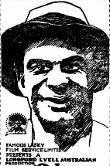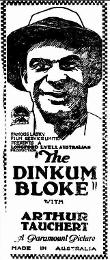
Latest Issues
AbstractHistoryArchive Description
'Bill Garvin, a Sydney dock-worker is happy in his Woolloomooloo home with his loving, hard-working wife, Nell, and their little daughter Peggy. Nell falls ill, however, and dies after an operation. Her last wish is that Peggy be brought up a lady. Bill sells the little house in order to place Peggy in an expensive convent school, but soon finds he must work after hours as a street singer to pay for the fees. Ten years pass and Peggy, now grown into a lovely young woman, spends a vacation on a Queensland property with school-friend Joy Gilder. Joy's brother, Geoffrey, falls in love with Peggy and Geoffrey's parents approve of the engagement. A dinner is planned at the Gilder's city home at Potts Point and Bill is invited. He buys a second-hand ill-fitting dinner suit and studies a book on etiquette but is not a social success at the dinner party, and he leaves ashamed of his poor showing and Peggy's evident embarrassment. The crisis worsens when the Gilders discover Bill singing on a street corner. Peggy breaks off the engagement and returns to the convent, where despite Geoffrey's pleas she determines to remain. Bill is aghast at the unhappiness he has caused, but finds inspiration in a story-book, The Prince and the Beggar Maid, which he had once given to Peggy years ago. He confronts the Gilders and tells them that Peggy is not his daughter at all but that her parents were swell English people and that she was adopted by the Gavins when her mother died and her father returned to England. The Gilders gladly believe the story and Bill visits Nell's grave to announce that her wishes have been carried out. Peggy, now accepted as a lady, is married to Geoffrey'.
Further reference: Andrew Pike and Ross Cooper. Australian Film 1900-1977, A Guide to Feature Film Production (1980), pp. 152-153.
Publication Details of Only Known VersionEarliest 2 Known Versions of
Works about this Work
-
American Combine : Australasian Films Ltd., and Block Bookings
2015
single work
criticism
— Appears in: Studies in Australasian Cinema , vol. 9 no. 3 2015; (p. 241-252) 'The 1927–1928 Commonwealth Royal Commission on the Moving Picture Industry in Australia followed a series of public inquiries into the Australian cinema. One agenda of the Commission was to examine the dominance of American movies in Australian film exhibition. By concentrating on how the Commission explored this issue, as it related to the exhibition and distribution of Hollywood movies in Australia, here I will consider the extent to which Australian exhibition has been guided by and dependent on American movies. With the Commission established, in part, to explore the accusation of an American combine ruling the exhibition industry, and stunting the local production sector, the real question was whether the Commissioners would be persuaded to make recommendations to wrest the powers from America, and consequently redirect the local exhibition industry's dependence on Hollywood movies.' (Publication abstract)
-
American Combine : Australasian Films Ltd., and Block Bookings
2015
single work
criticism
— Appears in: Studies in Australasian Cinema , vol. 9 no. 3 2015; (p. 241-252) 'The 1927–1928 Commonwealth Royal Commission on the Moving Picture Industry in Australia followed a series of public inquiries into the Australian cinema. One agenda of the Commission was to examine the dominance of American movies in Australian film exhibition. By concentrating on how the Commission explored this issue, as it related to the exhibition and distribution of Hollywood movies in Australia, here I will consider the extent to which Australian exhibition has been guided by and dependent on American movies. With the Commission established, in part, to explore the accusation of an American combine ruling the exhibition industry, and stunting the local production sector, the real question was whether the Commissioners would be persuaded to make recommendations to wrest the powers from America, and consequently redirect the local exhibition industry's dependence on Hollywood movies.' (Publication abstract)




